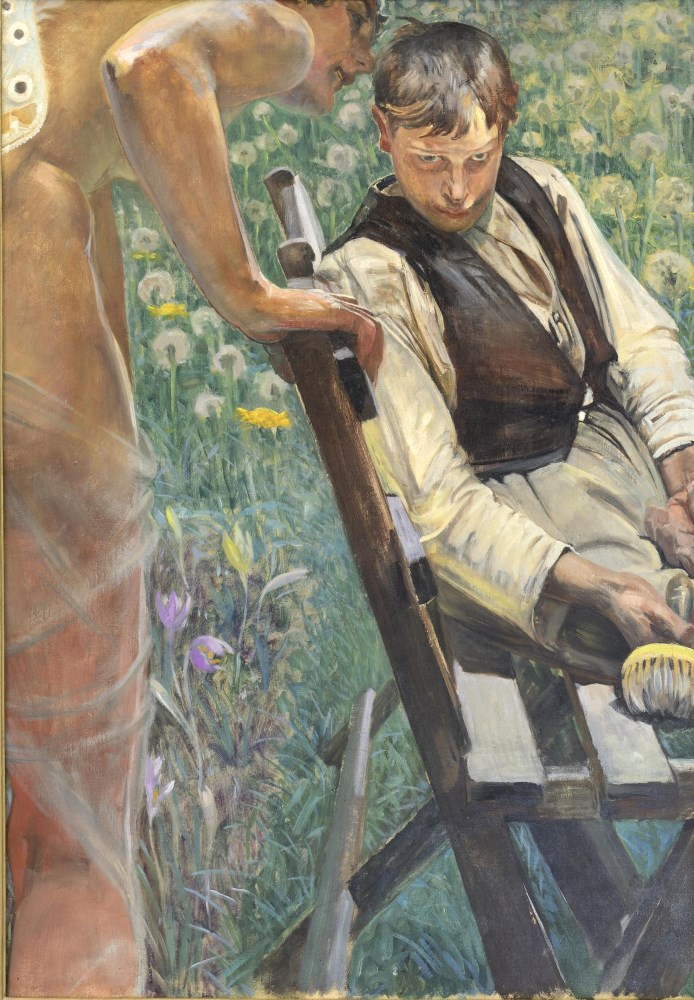Description
Malczewski (1854-1929) was very passionate about art and romantic literature, especially the poetry of Juliusz Słowacki, which he inherited from his family. He came from a noble but poor family. His father Julian supported him on his path to a career in painting. The events of 1863, the January Uprising and subsequent repression, left a deep impression on the young artist. His first teacher was Adolf Dygasiński. From 1867-1871, he spent his youth at the Karczewski manor in Wielgie. In 1873, he began his studies at the School of Fine Arts in Krakow under the tutelage of Jan Matejko. He was a student of Władysław Łuszczkiewicz. He also studied at the École des Beaux-Arts in Paris. He traveled to Italy, Vienna, Munich, Greece, and Minor Asia. From 1896-1900 and 1910-1914 he was a professor at the ASP in Krakow. From 1912-1914, he was its rector. His work began with an idealizing realism, then moved to naturalism, with the predominant theme of his work at this time being the fate of exiles in Siberia and the inspiration of Juliusz Słowacki’s “Anhellim”. At the same time, fantastic and allegorical views began to appear in Malczewski’s work. After his father’s death in 1884, the recurring motif in Malczewski’s work was Thanatos – the god of death. After 1890, his art became deeply symbolic. Works manifesting this turn towards the style of symbolism are: “Introduction” (1890), “Melancholy” (1890-1894), “Vicious Circle” (1895-1897). The artist tackled existential, historical and artistic issues. He intertwined ancient and biblical motifs with native folklore and the Polish landscape, so important in his work. Form, color, the monumentality of his representations and their expressiveness became his trademark.
Description of the painting:
The muse appearing in Jacek Malczewski’s work brings inspiration along with whispered words. Malczewski can draw from the native nature that fills the scene, from the partly fantastic and unreal figures, or from the mundane world of the senses. Her hints and the boy’s unique gaze in response become what distinguishes an artist from a painter, a creator from a craftsman. They initiate the process of the coming transformation and the self-awareness of the role assigned to an artist in history. Symbolically significant in this context are the mallow flowers appearing on the painting and their transformation into a full and mature dandelion.
The meadow is adorned and two figures are present, a woman and a young man. The scene is captured as if through a camera lens that is observing them. On the wooden bench sits the beginning artist-to-be. He holds a brush in his right hand and his left hand, resting on his leg, opens involuntarily in a gesture of rest, but also of expectation. The figure of the boy facing the viewer and his focused gaze ahead create an immediate and intimate contact. This feeling is intensified by the woman standing behind the painter. She is nude; the sheer fabric that was just covering her hips drops down. On her back, we can see a fragment of a butterfly wing. The woman, a fairy, bends over the boy and whispers something in his ear. The way the scene is framed, the composition emphasize the second-tier position of the woman. Her figure repeats the contour of the canvas’ border, setting its bodily frame. Yet, the dominant element of the representation remains the painter with his deeply embedded gaze in us.
The surrounding nature is significant. The meadow is divided into two strips with different vegetation. The first one, reaching halfway through the painting, is decorated with blossomed crocuses, symbolizing spring, youth, joy, and developing life. The saffron obtained from the flowers is used, among other things, to produce perfumes, the smell of which stimulates the senses, like the words whispered by the painted woman.
The second vegetation is a spread of dandelions and yellow mallow flowers. Their bitter taste may foreshadow the worries of the young man. Eventually, however, they will transform into dandelions, symbolizing freedom, maturity, but also the necessity of starting the next stage of life, the unavoidable change. They are extremely delicate, and under the influence of a gentle breeze, they scatter their seeds. They may signify the unlimited possibilities of artistic development. Often associated with them is also the instability of male feelings. It is not without significance that the mallow flower came to our region from the territory of Greece, the ancient home of the muses. Both plants, crocus and dandelion, become painterly symbols of the successive stages of initiation of an artist: initiating, preliminary, early, spring, searching and already mature, fully aware and directed.


